Throughout football history, tactical ideas constantly changed. Some ideas are tested, and then thrown away, never to come back again. Then again, some ideas are brilliant, but tend to lose their effectiveness when opponent’s find countermeasures. These ideas disappear for some while, yet later on, they reappear much improved and more genius than ever. When Pep Guardiola installed Lionel Messi as false nine at Barcelona, the public praised the Catalán coach. The concept of a false nine – a central forward dropping back to create holes when defenders follow him and move out of the back line – was also used back in the early 1950s though. The famous Hungarian national team used this tactic, with Nándor Hidegkuti as false nine. Guardiola’s rediscovery of this concept revolutionized modern football, yet physically strong strikers are still nowhere near becoming extinct. Robert Lewandowski, Harry Kane or Karim Benzema, just to name a few, still represent the prototype of a “real” number nine. For many years, classical strikers were seen as the most important piece of a team. Beside their physical strength, the common opinion was that they know how to position inside the box and oppose a constant threat to the opponent. They have great finishing ability, yet they were seen as players who lack the technical ability of their teammates. Legends like the great Filippo Inzaghi made it look like their team had one player less on the field, but when the moment came, they put the ball in the back of the net.
In our tactical analysis, we will examine statistics to get an idea on how important this player type is. After that, this analysis will provide some focal points that statistics might not fully model.
Data set
For the first part of our analysis, the statistical analysis, we will examine a short list of 30 players. To choose the relevant players for this list, we took the expected goal ranking of all big five leagues (England, Spain, Germany, Italy and France) and identified the top 30 players. Bear in mind that due to sample size issues, we did not use expected goals per game, but rather total expected goals in the 2019/20 season. The reason for using expected goals instead of actual goals is that we want to minimize hazardous effects. A goal from the halfway line might look spectacular, but mostly involves a lot of luck as well. While the actual goals still count that goal fully in, the expected goals metric rules it out (or at least make it considerably small).
Touches in Box / Conversion rate
After having determined our list, we first compare the number of touches inside the box per 90 minutes. This metric will give us an idea on how present and active a player is near the post. Additionally, we have a look at the conversion rate, meaning that we now compare expected goals with actual goals. Coming back to our example from before: If someone scores from the halfway line, then actual goals will exceed expected goals massively. Let’s say expected goals is 0.01 in this case, saying that you will need to try 100 times to score once. While we wanted to rule this out when finding our data set, now this will show us how good a player is at overachieving. We first determined the players who create the highest chances, and now we are analysing how good they are in converting these chances.
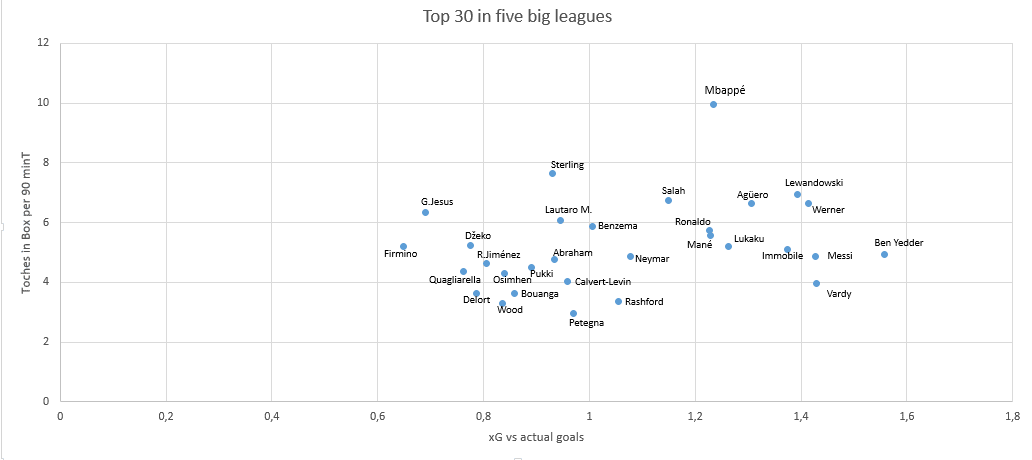
Looking at the vertical axis, we see that Kylian Mbappé has by far the most touches inside the box. Unsurprisingly, players like Raheem Sterling, Mohamed Salah, Sergio Agüero or Timo Werner have also a lot of touches inside the box. These players love to dribble and penetrate inside the box. It is Robert Lewandowski (and in parts Gabriel Jesus) who stands out, being able to produce more than six touches inside the box as a classical striker. If we look at the bottom of this axis (4 touches or less), we see those physical goalscorers, who usually do not participate a lot in the game, but know how to score. Players like Jamie Vardy, Andrea Petagna, Chris Wood or Andy Delort seemingly go for the shot much faster than others. Probably, their ability to receive crosses and make a header play into it as well, since most likely you are not able to produce more than one touch with your head after a cross. It is much more likely, that they head it towards the post immediately.
Looking at the conversion ratio on the horizontal axis, it is incredible how the elite players seem to outscore their expected goals. The ratio is calculated by actual goals/expected goals, so everything greater than one shows that a player exceeded expectations. If you, the reader, have been given the list prior to seeing the numbers, and you would have been told to pick the 15 best players from that list, most likely with one or two exceptions you probably chose those reaching a conversion ratio greater than one(every point right of Benzema). Surprisingly though, the top player here is Wissam Ben Yedder (18 actual goals/11.56 expected goals). Looking at classical strikers, we see Lewandowski, Vardy, Romelu Lukaku and Ciro Immobile performing superbly.
Passes / shot assists
Coming back to the Inzaghi point, we now want to examine how much these players contribute to their teams’ offensive game besides scoring. To do that, we look at the number of passes they attempt per 90 minutes as well as shot assists per 90 minutes.
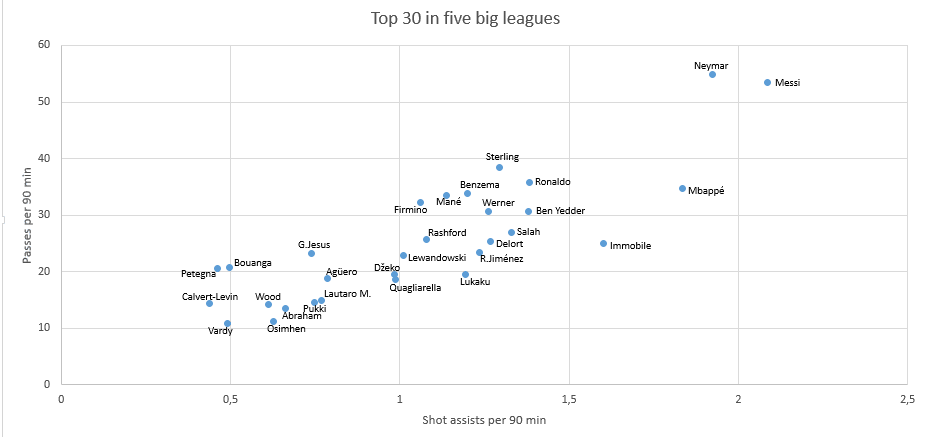
Immediately, we see here that Messi and Neymar stand out both in passing volume and shot assists. Messi even exceeds the threshold of two shot assists per 90 minutes, which is simply insane. For classical strikers, Benzema and Immobile produce fantastic stats. Being so active, Benzema is a perfect example for how strikers evolved through the years, taking part in the game and functioning as additional passing option up-front. Immobile on the other hand proves that despite playing around ten passes per 90 minutes less than Benzema, he adds value to his team in a different manner. As he is such a great scorer, the opponent marks him tightly, but Immobile is able to find spaces that open up as well and thus creates opportunities for his teammates as well.
On the other side of the medal, we have Jamie Vardy. Only ten passes per 90 minutes combined with less than 0.5 shot assists per 90 minutes proves that he is a dinosaur, representing a player type from the 90s. Nonetheless, Leicester City are currently third in the Premier League. Vardy’s extraordinary finishing ability seemingly compensates for all the negative aspects of his game. Chris Wood and Burnley are also doing fine, same like Tammy Abraham and Chelsea. Likewise, OSC Lille with Victor Osimhen are currently fourth in the Ligue 1.
However, there are some teams who are not doing great despite having one player on our list. Everton with Calvert-Levin are mediocre, while Norwich with Teemu Pukki are dead last. Andrea Petagna’s Spal are 19th in Seria A, Denis Bouanga and St.Étienne are 17th. Fabio Quagliarella’s Sampdoria are also fighting against relegation, being 16th. But then again, Lautaro Martínez, Gabriel Jesus and Sergio Agüero are also in that bulk down low.
The picture gets blurrier when we look at the pass success ratio, where Jesus and Agüero come up on top.
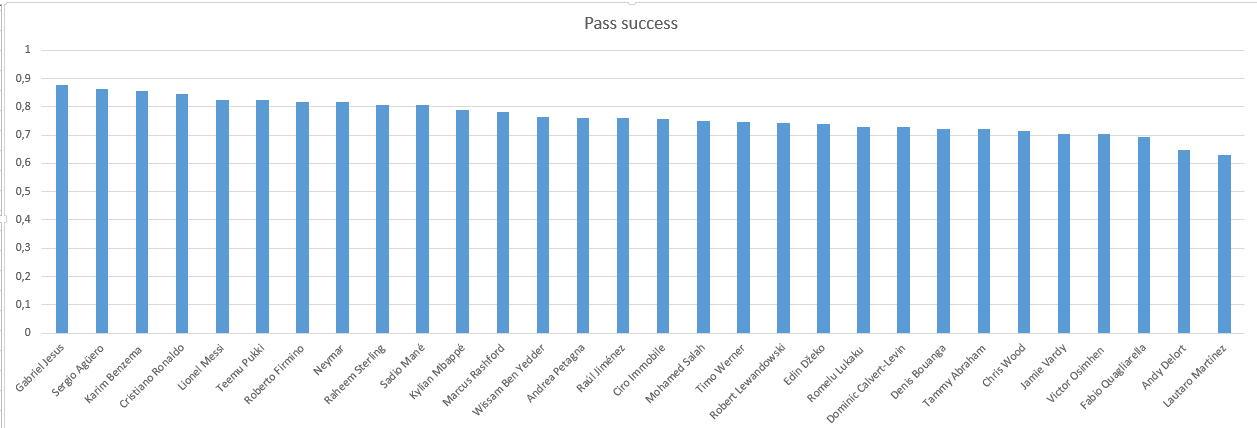
This just indicates that City are using their central forward in a special way. The quantity of their passes is somewhat average, but the shot assists number are very low which can be explained by City’s use of an “extra-pass” to find an even better positon to score. Manchester City’s forwards are laying the ball off quite often, which boost the pass success ratio, but the receiver does not shoot the ball. For City’s style of play, it is favourable when the central forwards do not risk a turnover, but rather play it safe. Likewise, Leicester City’s game favours Vardy. For Brendan Rodgers, it is not important to have Vardy as passing option. He understands that the team needs Vardy’s finishing skills.
It is important though for the teams that are down in the table to analyse what went wrong. For Norwich as an example, it could be interesting to notice Pukki’s figures. In terms of passing success, he matches Ronaldo, Messi and Firmino. However, his passing volume is considerably low, which somewhat nullifies the high passing success. The same applies for shot assists, which are quite low as well and could be a sign of Pukki being all on his own up-front, since he should potentially have the quality to play assists. While Norwich are a team that prefer to play short passes, a classical striker who can also win aerial duels could thus be considered. Pukki could then play as a second striker in a 4-4-2. Not having an aerial threat or the option of playing long balls seemingly is an offensive weakness for Norwich, even though further in-depth analysis is required here.
In total, we can say that it strongly depends on the coaches’ philosophy whether a certain player type functions or not. Jamie Vardy may be the best example here. Nonetheless, world-class strikers like Robert Lewandowski or Karim Benzema produce fantastic numbers and show us how classical strikers can evolve, too. On the other hand, the high number of non-classical strikers, or even wingers like Raheem Sterling, Sadio Mané or Mohamed Salah in this list is a clear sign that a lot of different roads can lead to the destination.
In-Game example – Tottenham
While statistics may show us a certain direction, the eye-test should not be neglected. Of course, when you have such a diverse and debatable topic, it becomes difficult to highlight certain aspects. Nonetheless, we want to provide some example to show potential benefits of having a real striker.
First, we checked Tottenham with and without Harry Kane. When Kane got injured, Coach José Mourinho put Lucas, Dele Alli or Heung Min Son up-front. All these players are not classical strikers though, so obviously Tottenham’s game changed.
When Kane was on board, the opponent shifted their focus on him.
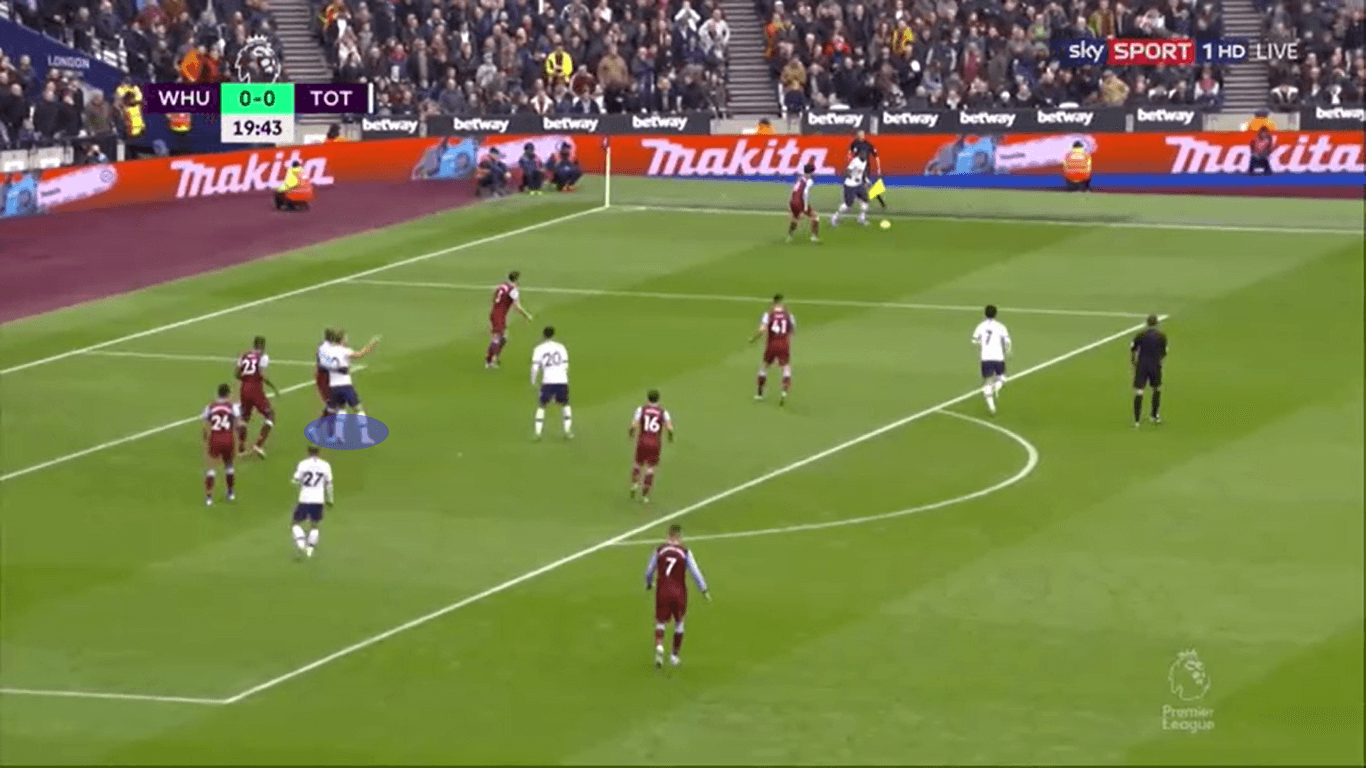
Especially in situations where the ball was on the wing, the defence had to be on alert. When a cross comes in here, Kane will be the target player, so West Ham mark him closely. Thus, Alli is open in the penalty area and could potentially takes advantage of it. While this is only one small example, there are tons of other situation in every game where the presence of a player like Kane creates space for others. There is not even the need for a world-class striker to create space in this specific situation. The threat is important here, so it would be still the same if Andy Carroll or Peter Crouch were there.
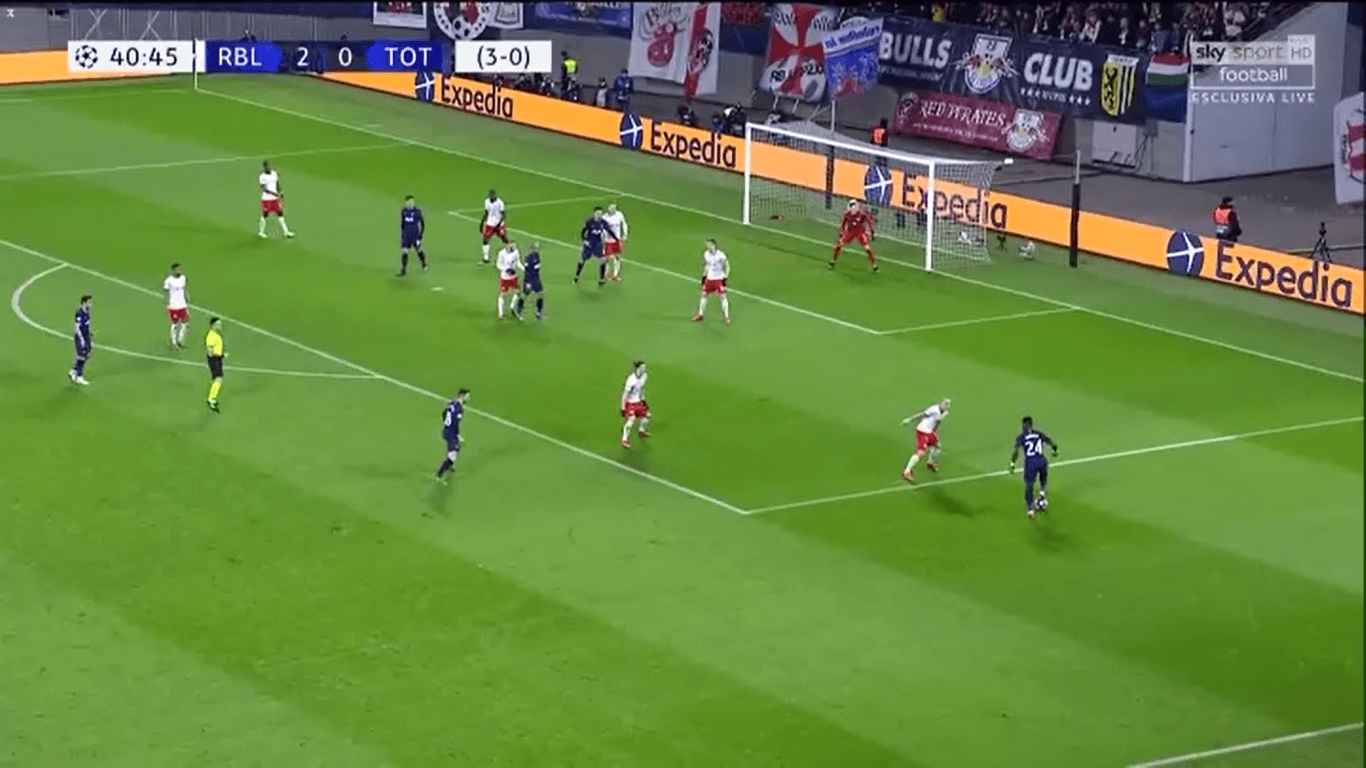
When there is no immediate threat, it becomes much more difficult to open up spaces. Here, Tottenham have three players inside the box, but man-to-man marking with one additional defender defending the space is sufficient. This situation can only become difficult if Sergé Aurier made a low cross. Since this is the only threat here, Leipzig can shift their whole attention to it and will not be surprised by any means.
In-Game example – Dortmund
A similar issue can be seen at Dortmund. Their 2019/20 season itself would be a great opportunity for an in-depth analysis of this topic alone. Coach Lucien Favre, known for not being a fan of classical strikers ever since, tried many different approaches to find a suitable solution. During the winter break, they finally decided to buy a classical striker and signed Erling Braut Haaland.
In the first game after the winter break, Dortmund were already down 3-1 against Augsburg when Haaland came in. Here, we have an example from the first half:

Augsburg did not even try to put pressure on the ball when it was on the wing. There was simply no threat of Dortmund crossing the ball into the box. Also, there is no Dortmund player near the opponent’s centre-backs, so Augsburg are free from danger. Dortmund tried to combine through the centre, but Augsburg knew that this was their only solution, which made it easier to anticipate the following pass.
When Haaland was substituted in, the situation changed.
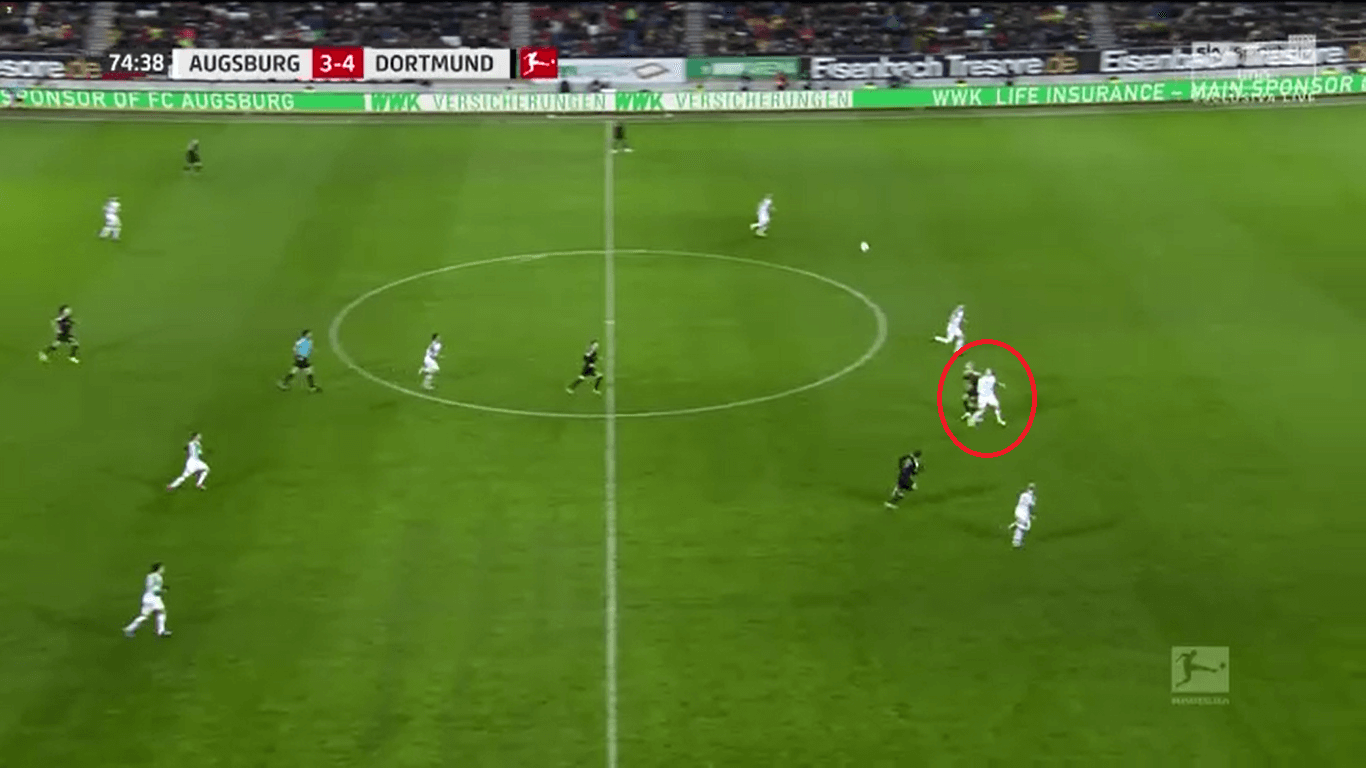
All of the sudden, Dortmund could play long ball in the build-up, leading to situation like in the image above. Augsburg’s high press had worked fine in the first half, but here they have to run back quickly as they are overplayed with a high ball. Haaland wins the aerial duel against the defender and lays the ball off to his teammate, creating a four-on-four position. Augsburg’s whole game-plan was shattered and in the end, Dortmund won 5-3.
In-Game example – Barcelona
In the last clásico, Barcelona faced similar issues as well. Since the injury of Luís Suárez, the Catalans are in search for a solution to their striker-problem. They played with Antoine Griezmann and Lionel Messi up-front in that game, two players who like to fall back a lot and participate in the game.
Consequently, situations like the following arose:
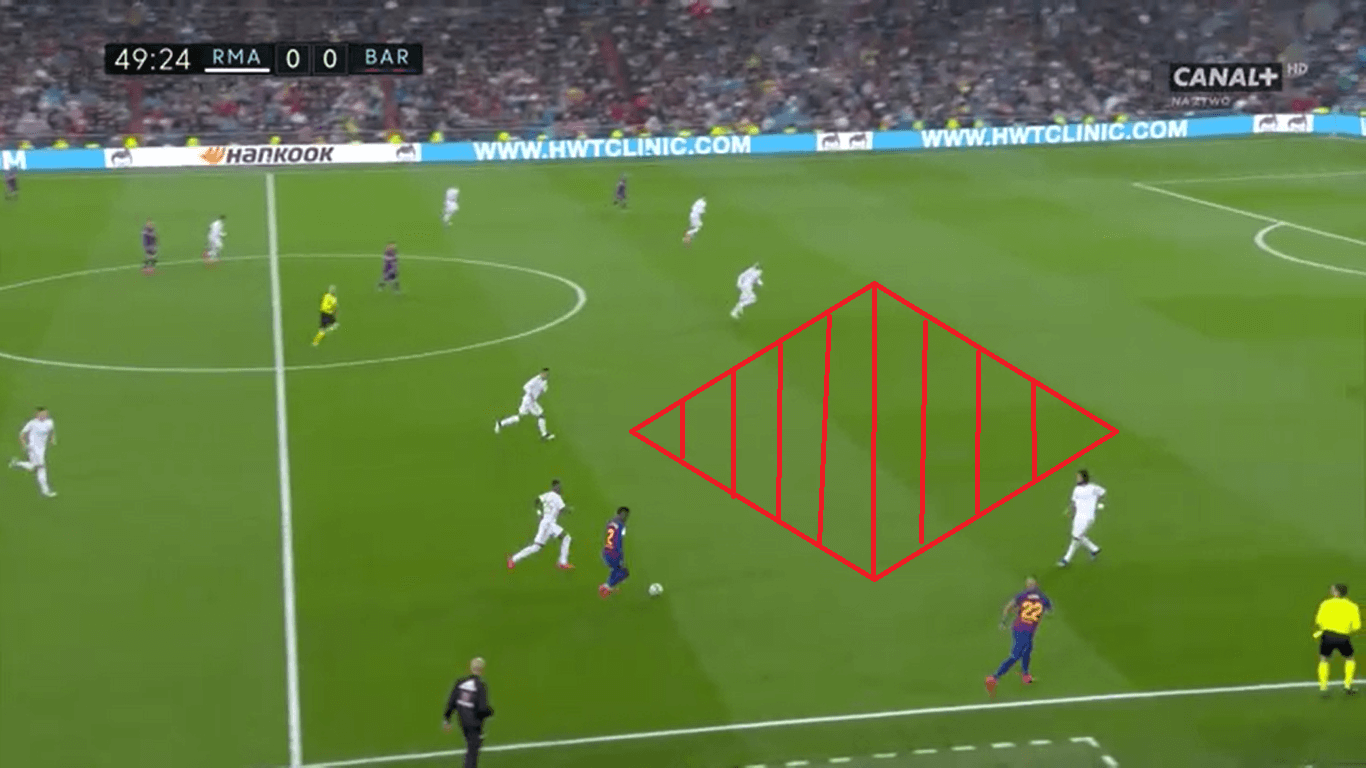
They lacked presence in the final third and had no passing option in deeper areas. Had there been Suárez, a vertical pass could have been played. Surely, Real Madrid would then defend in a different manner, closing that space. But that would have created space somewhere else. There is nothing more frustrating than opening up spaces and not being able to exploit it though.
Also, even when Barcelona had presence in or near the box, it was not dangerous for Madrid still.
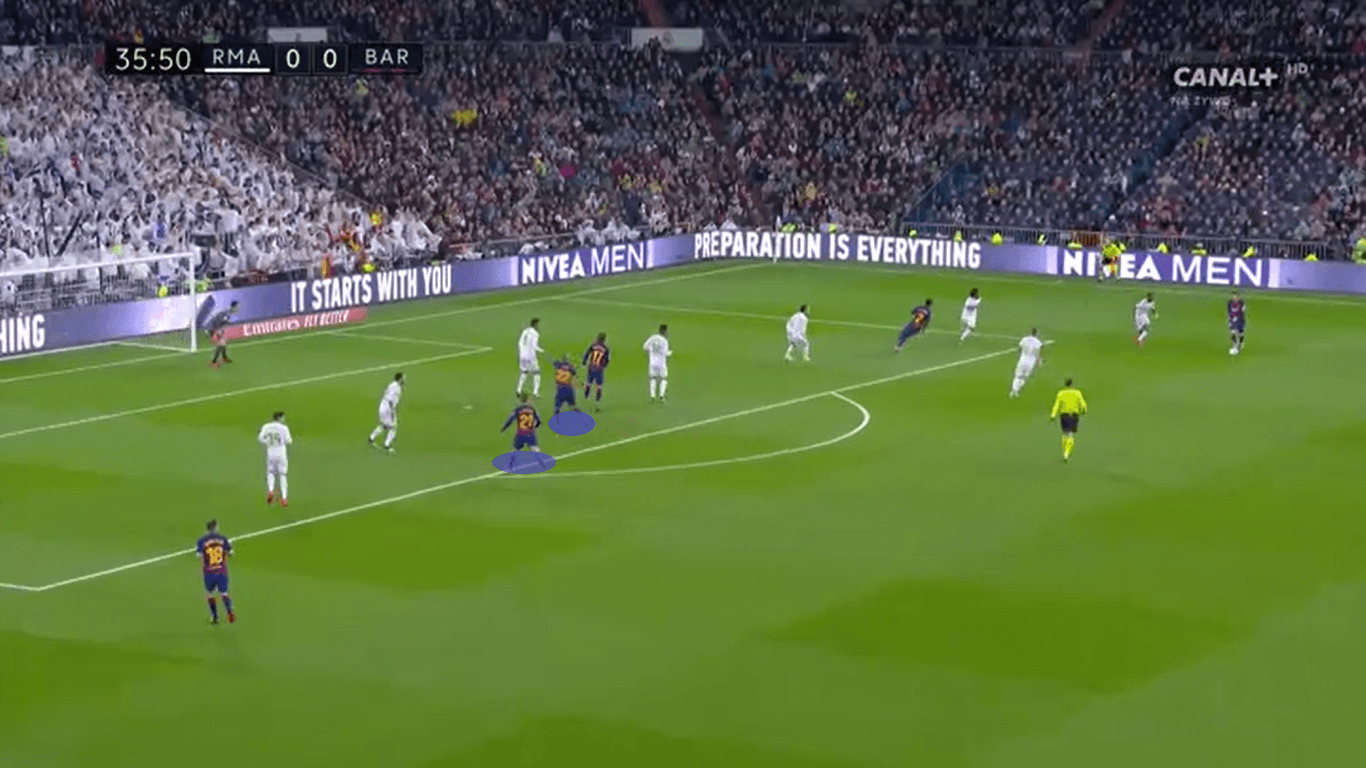
Here, the midfielders Frenkie de Jong and Arturo Vidal make a run into the box. While Vidal is indeed capable of scoring goals, it is still not likely that he will create problems for Raphaël Varane. Seemingly, it would be even more dangerous if Frenkie de Jong was where the referee is positioned in this scene. Since they lack a real striker, they try to overcompensate this though with midfield-runs into the box. While this makes sense, finding the right balance is also important. They would not have to do such things if they had a real striker though.
Conclusion
This statistical and tactical analysis gave an idea on how important real strikers still are, even in modern football. For teams operating at the highest level, strikers who have evolved into more complete players like Lewandowski or Benzema are of high value. Still, a limited player like Vardy can also be incredibly valuable, if used perfectly. In that sense, we always have to keep the bigger picture in mind when evaluating players. Fitting into a teams’ structure still is extremely important. Therefore, it is logical that we cannot make an absolute statement whether a team needs a classical striker or not. It depends. Besides stats, the eye-test shows us that there are for sure certain benefits of having a classical striker. On the other hand, Coaches defending a different philosophy are certainly able to make valid points in order of not needing such a player type. In the end, it will come down to judging whether the amount of goals scored by a striker makes up for other deficits or not.





Comments